Events
The annual partner meeting of VITAFORT Zrt. is always closely followed by the professionals. The company welcomes and entertains its business associates and professional partners with high-quality lectures, professional programs and delicious food and drinks. At the partner meeting organized on 2nd June this year, we participated as a prominent exhibitor in the context of our long-lasting commercial and research collaborations with VITAFORT Zrt., and in addition to our innovative products we presented the services of our Correltech Laboratory. In the section dealing with ruminants’ nutrition, Dr. Tamás Tóth, managing director of ADEXGO Kft., gave a presentation in which he focused on the importance of research in the field of feed testing, focusing on the analytical and practical challenges of NIRS technology and instrumental aroma analysis.
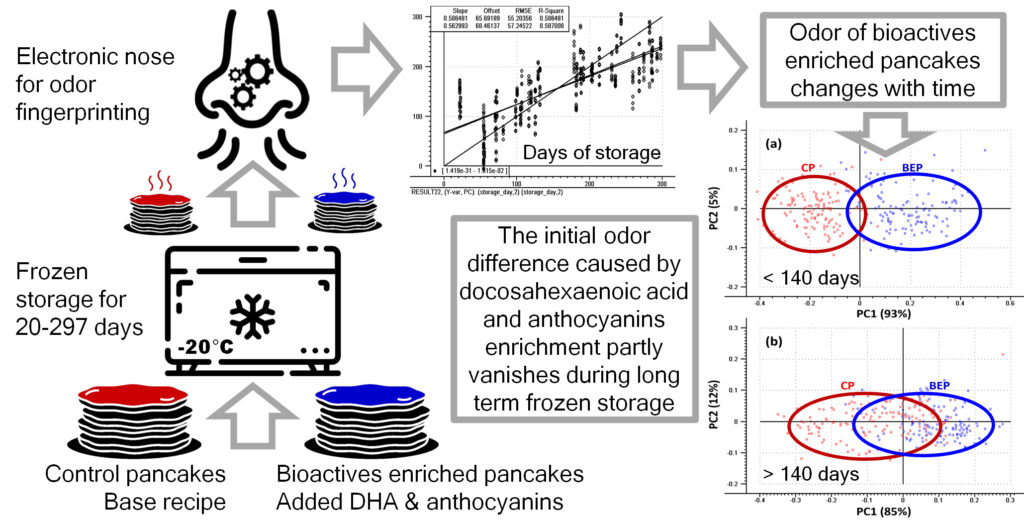
News
As a member of an EU FP7 tender consortium, ADEXGO Kft. participated in the development and comprehensive analytical, economic and nutritional physiological examination of bioactive enriched functional foods with health-promoting effect. The results of the aroma analysis of the food produced in the project were summarized in a paper published in the peer-reviewed scientific journal Food Analytical Methods.
Machine olfaction to evaluate the stability of the odor profile of pancakes enriched with docosahexaenoic acid and anthocyanins
George Bazar, Hajnalka Hingyi, Éva Csavajda, Csaba Palkó, Haruna Gado Yakubu, Carlos Pineda-Vadillo, Didier Dupont, Francesco Capozzi, Alessandra Bordoni, Tamás Tóth
Increasing consumer awareness on good health has drawn the attention to health promoting natural dietary substances. However, since the organoleptic profile of foods highly influences the consumers’ preference, and it is often decisive in the purchase, it is important to objectively describe and evaluate the effect of the applied bioactive ingredients on aroma. In this study, pancakes enriched with docosahexaenoic acid and anthocyanins were tested with electronic sensor array technology against control products. Samples were analyzed with an Alpha MOS FOX4000 electronic nose (EN) after 20 to 297 days of frozen storage at -20°C. Multivariate analysis of the acquired EN data showed a strong relation between the number of days that samples were stored and the odor describing sensor signals of enriched samples (R2 = 0.59), but the observed relation was broken in the case of control (not enriched) samples (R2 = 0.08). When a supervised classification of enriched and control samples was done, the ratio of correctly identified samples in cross-validation was 95.1% at short-term storage (< 140 days), while the hit rate dropped to 80.4% at prolonged storage (> 140 days). This signified the existing but less intensive odor differences. The electronic nose technology was proven to be applicable in the characterization of one type of bioactive-enriched foods, while it was also useful in the monitoring of odor alterations during storage.

Purchase the full paper on the website of the journal or contact us and request a copy from the authors:
» Machine olfaction to evaluate the stability of the odor profile of pancakes enriched with docosahexaenoic acid and anthocyanins

Instrumental Aroma Analysis
As a member of an EU FP7 tender consortium, ADEXGO Kft. participated in the development and comprehensive analytical, economic and nutritional physiological examination of bioactive enriched functional foods with health-promoting effect. The results of the aroma analysis of the food produced in the project were summarized in a paper published in the peer-reviewed scientific journal Food Analytical Methods.
Machine olfaction to evaluate the stability of the odor profile of pancakes enriched with docosahexaenoic acid and anthocyanins
George Bazar, Hajnalka Hingyi, Éva Csavajda, Csaba Palkó, Haruna Gado Yakubu, Carlos Pineda-Vadillo, Didier Dupont, Francesco Capozzi, Alessandra Bordoni, Tamás Tóth
Increasing consumer awareness on good health has drawn the attention to health promoting natural dietary substances. However, since the organoleptic profile of foods highly influences the consumers’ preference, and it is often decisive in the purchase, it is important to objectively describe and evaluate the effect of the applied bioactive ingredients on aroma. In this study, pancakes enriched with docosahexaenoic acid and anthocyanins were tested with electronic sensor array technology against control products. Samples were analyzed with an Alpha MOS FOX4000 electronic nose (EN) after 20 to 297 days of frozen storage at -20°C. Multivariate analysis of the acquired EN data showed a strong relation between the number of days that samples were stored and the odor describing sensor signals of enriched samples (R² = 0.59), but the observed relation was broken in the case of control (not enriched) samples (R² = 0.08). When a supervised classification of enriched and control samples was done, the ratio of correctly identified samples in cross-validation was 95.1% at short-term storage (< 140 days), while the hit rate dropped to 80.4% at prolonged storage (> 140 days). This signified the existing but less intensive odor differences. The electronic nose technology was proven to be applicable in the characterization of one type of bioactive-enriched foods, while it was also useful in the monitoring of odor alterations during storage.

Purchase the full paper on the website of the journal or contact us and request a copy from the authors:
» Machine olfaction to evaluate the stability of the odor profile of pancakes enriched with docosahexaenoic acid and anthocyanins
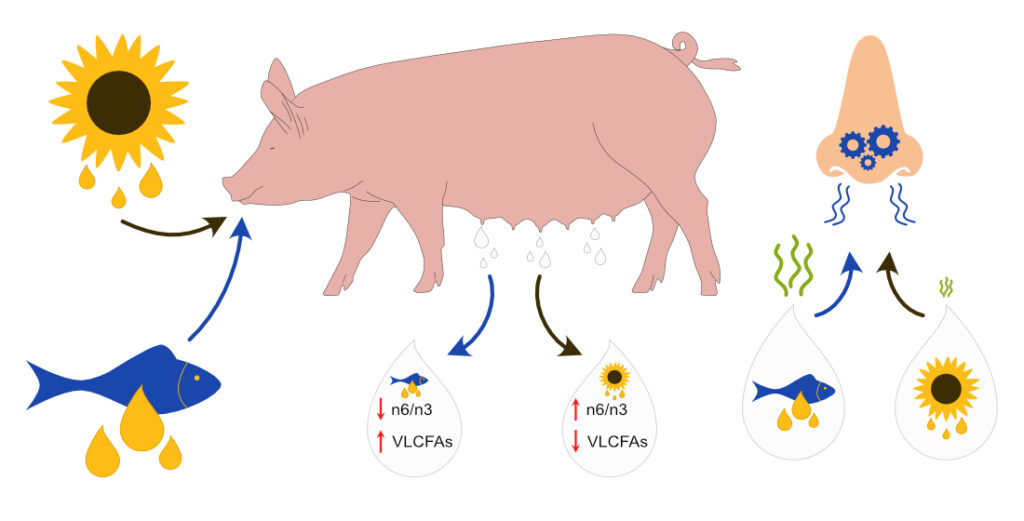
Animal Nutrition and Physiology, Instrumental Aroma Analysis
In the development of supplementary feeds, more and more emphasis is being placed on n-3 polyunsaturated fatty acids and their sources. However, an important question is how these fatty acids are incorporated into the animal’s body or the resulting animal products at a given dose. An article presenting the results of the research carried out in this field by the staff of ADEXGO Kft., Széchenyi University and MATE was published in the peer-reviewed Journal of Applied Animal Research.
Effect of n-3 Polyunsaturated Fatty Acid Feeding on the Fatty Acid Profile and Odour of Milk in DanBred Sows
Robert Roszkos, George Bazar, Tamás Tóth, Zoltan Kovacs, Hedvig Febel, Miklós Mezes
The effects of n-6 and n-3 fatty acid supplementation on the fatty acid profile of sow milk were investigated using traditional fatty acid analysis and a novel method of the electronic nose (EN). The control group received 6.3 g of sunflower oil (SO) rich in n-6 fatty acids per kg feed, and experimental animals received the same amount of fish oil (FO) as an n-3 fatty acid source. The diets were corn- and soybean meal-based diets. Supplementation of SO enhanced the amount of linoleic acid (C18:2, n-6) (SO: 8.43 mg/mL vs. FO: 6.63 mg/mL milk), and significantly increased (p < 0.02) the amount of total polyunsaturated fatty acids (SO: 9.92 mg/mL vs. FO: 8.61 mg/mL milk) in the sow’s milk. On the contrary, FO significantly increased the amount of n-3 polyunsaturated fatty acids (FO: 1.17 mg/mL vs. SO: 0.69 mg/mL milk), especially eicosapentaenoic acid (C20:5, n-3), docosapentaenoic acid (C22:5, n-3), and docosahexaenoic acid (C22:6, n-3), in the milk (p < 0.001). FO and SO supplementation did not affect the analytical composition of milk. Milk samples collected from the differently fed individuals could be clearly separated according to the feeding groups based on the odor profile described by the EN.

Access the full paper free of charge on the website of the journal:
» Effect of n-3 Polyunsaturated Fatty Acid Feeding on the Fatty Acid Profile and Odour of Milk in DanBred Sows
Articles
In the previous issue, we explained how important it is to be aware of the reliability of the data available and underpinning our decisions. In this issue, we show some examples where openness to accepting the possibility and fact of error has led to benefits. We highlight some of our scientific publications, which can be accessed and thoroughly reviewed by readers deeply interested in this field.
Data is important, but its meaning is even more important (Part 2)
Events
Nearly 400 participants registered for the 13th Hungalimentaria conference organized by the National Food Chain Safety Office and WESSLING Hungary Kft. The motto of the conference: “Public and private laboratories together for food safety”. The activity of ADEXGO Kft. related to the aroma testing of foods was presented by Dr. György Bázár, head of research.
Summary of the presentation:
Food quality control by aroma testing
The costliest element of animals farming is feeding. Consequently, the feeding of farm animals is significantly influenced by the pursuit of efficiency gains. Maximization of feed utilization is achieved by feeding precisely formulated complete feed mixtures and feed rations to animals bred for intensive production. On the one hand, this practice results in animal products of uniform quality, which, however, often do not meet the increased needs of consumers for palatability and nutritional value. On the other hand, the pursuit of intensive production may lead to a deterioration in the physiological parameters of farm animals, thus posing an animal health risk. These effects put significant challenges on the economy-oriented producer in the long run, so compensating for the negative effects is essential. Nowadays, supplementary feeds and additives are an important part of recipes. They are used, inter alia, to:
(1) prevent or treat metabolic diseases in intensively farmed animals;
(2) to increase the nutritional quality of the food (raw material) produced, thereby producing a value-added functional food rich in bioactive ingredients that support human health.
Both directions can result in animal products with altered nutritional physiological and organoleptic properties. Therefore, monitoring and evaluating the impact of such and similar interventions on the quality of food raw materials is becoming increasingly important. This presentation attempts to summarize scientific researches in which the effect of supplementary feeds on food quality were investigated using classical chemical analysis, human sensory panel, and instrumental aroma testing technology. The results cover the areas of dairy, egg, pork and poultry production, providing a comprehensive overview of the impact of feed on food quality.
Events
The 1st Agrofeed International Monogastric Symposium (AIMS) was held in Siófok (Hungary) between November 8 and 9, 2021. At the event, renowned foreign and domestic keynote speakers as well as the world’s leading manufacturers of innovative feed supplements and additives presented their latest experimental results and experiences. The symposium focused on novel feeding strategies to reduce the use of antibiotics and prevent digestive disorders in poultry and pigs.
ADEXGO Kft. participated in the AIMS as a sponsor and exhibitor of the symposium and introduced its feeding concept to several domestic and foreign partners.
News
Hungarian researchers were the first in the world to publish the results of digestive physiological studies based on electromyographic measurements performed on awake, growing pigs kept under farm conditions. The scientific publication presenting the results of the research conducted by the coworkers of ADEXGO Kft., Hungarian University of Agriculture and Life Sciences, MSB-MET Kft. and University of Szeged was published in PLoS ONE, a highly ranked multidisciplinary peer-reviewed scientific journal.
Click here for a more detailed summary!
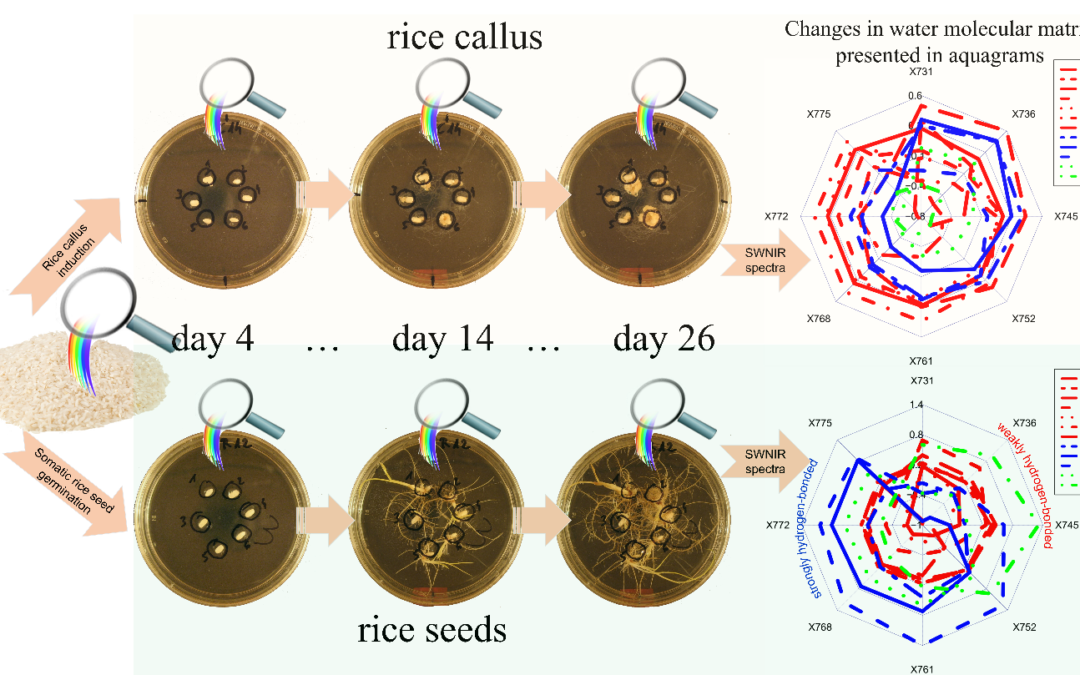
Near-infrared Spectroscopy
Near-infrared spectroscopic measurements performed in Japan and a special data analysis method provide new knowledge for a more detailed understanding of certain degenerative processes in plants. The study published by the staff of Kobe University, MATE and ADEXGO Kft. was published in the peer-reviewed journal Plants. The research team has played a significant role in the development and refinement of the aquaphotomics data analysis methodology, and a number of different applications have been reported in recent years.
Water spectral patterns reveals similarities and differences in rice germination and induced degenerated callus development
Zoltan Kovacs, Jelena Muncan, Nobuko Ohmido, George Bazar, Roumiana Tsenkova
In vivo monitoring of rice (Oryza sativa L.) seed germination and seedling growth under general conditions in closed Petri dishes containing agar base medium at room temperature (temperature = 24.5 ± 1 °C, relative humidity = 76 ± 7% (average ± standard deviation)), and induced degenerated callus formation with plant growth regulator, were performed using short-wavelength near-infrared spectroscopy and aquaphotomics over a period of 26 days. The results of spectral analysis suggest changes in water absorbances due to the production of common metabolites, as well as increases in biomass and the sizes of the samples.
Quantitative models built to predict the day of the development provided better accuracy for rice seedlings growth compared to callus formation. Eight common water bands were identified as presenting prominent changes in the absorbance pattern. The water matrix of only rice seedlings showed three developmental stages: firstly expressing a predominantly weakly hydrogen-bonded state, then a more strongly hydrogen-bonded state, and then, again, a weakly hydrogen-bonded state at the end. In rice callus induction and proliferation, no similar change in water absorbance pattern was observed.
The presented findings indicate the potential of aquaphotomics for the in vivo detection of degeneration in cell development.
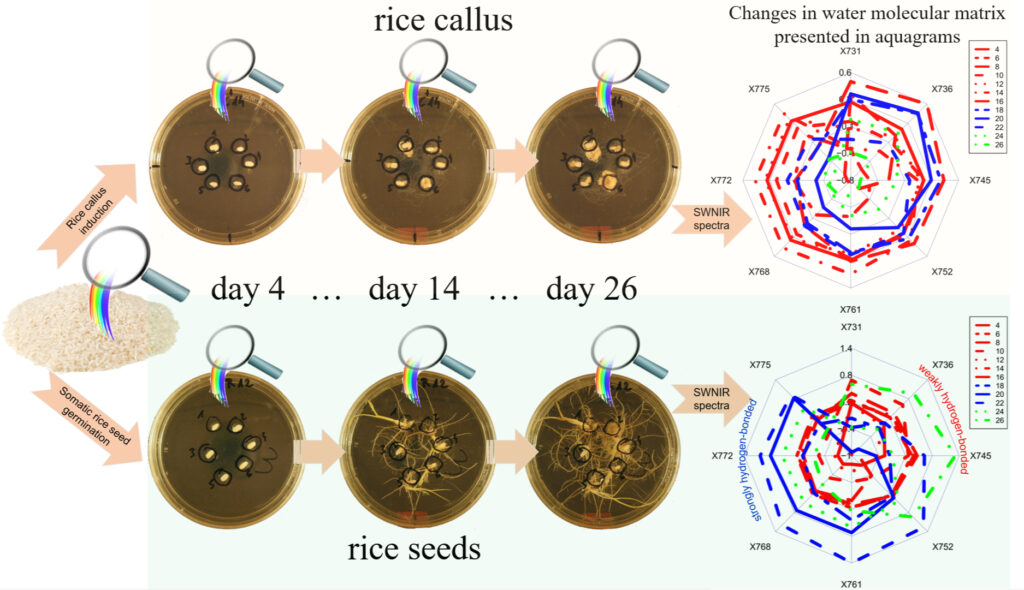
Access the full paper free of charge on the website of the journal:
» Water spectral patterns reveals similarities and differences in rice germination and induced degenerated callus development

Animal Nutrition and Physiology
Hungarian researchers were the first in the world to publish the results of digestive physiological studies based on electromyographic measurements performed on awake, growing pigs kept under farm conditions. The scientific publication presenting the results of the research conducted by the coworkers of ADEXGO Kft., Hungarian University of Agriculture and Life Sciences, MSB-MET Kft. and University of Szeged was published in PLoS ONE, a highly ranked multidisciplinary peer-reviewed scientific journal.
Non-invasive smooth muscle electromyography (SMEMG) as a novel monitoring technology of the gastrointestinal tract of awake, free-moving pigs—A pilot study
Katalin Nagy, Hedvig Fébel, George Bazar, György Grosz, Róbert Gáspár, Kálmán Ferenc Szűcs, Tamás Tóth
There are several mathematical models and measurements to determine the efficiency of the digestibility of different feedstuffs. However, there is lack of information regarding the direct methods or measurement techniques used to analyse the physical response of the different parts of the gastrointestinal tract (GIT) of growing pigs to different diets. Smooth muscle electromyography (SMEMG) is a non-invasive method for the measurement of gastrointestinal myoelectrical activity. In the present study, SMEMG methodology has been adapted from laboratory rats to pigs, and the effects of feedstuffs with control (CTR) or experimentally increased (EXP) amounts of fibre were investigated on gastrointestinal tract motility. Nine barrow pigs ((Danish Landrace × Danish Yorkshire) × Danish Duroc) were used (30 ± 3 kg), and their CTR and EXP feedstuffs contained 29 and 49 g/kg crude fibre (CF), respectively. Myoelectric activities of the stomach, ileum and caecum were detected in the awake pigs by a pair of electrodes. The recorded myoelectric signals were analysed with fast Fourier transformation (FFT), and the spectra were expressed in GIT section-specific cycles per minutes (cpm) values and the maximum power spectrum density (PsDmax). A significant increase (P < 0.001) was observed in the value of the PsDmax of the small intestine (20–25 cpm) as a consequence of the EXP diet. The PsDmax values of the stomach (3–5 cpm) and large intestine (1–3 cpm) did not show any significant change in pigs fed the EXP diet. As a direct and non-invasive method, SMEMG is suitable for the rapid evaluation of the effects of diets with different fibre contents on the GIT of non-anaesthetised, free-moving pigs.
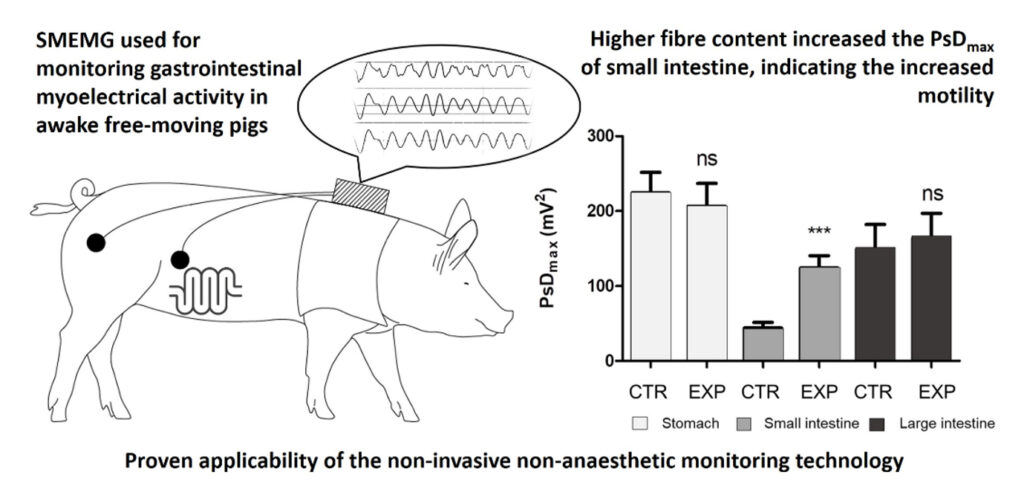
Access the full paper free of charge on the website of the journal:
» Non-invasive smooth muscle electromyography (SMEMG) as a novel monitoring technology of the gastrointestinal tract of awake, free-moving pigs – a pilot study






